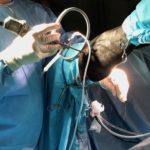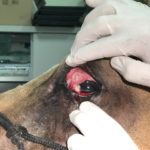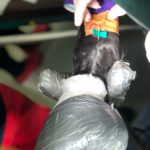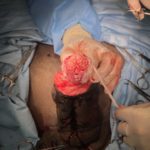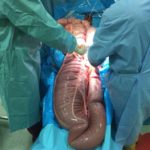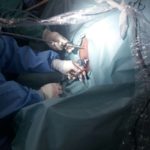The Equine Medicine and Surgery Unit works as a first opinion and referral practice, providing advanced diagnostic and therapeutic services as support to the equine practioneers.
Equine emergencies are admitted 24/7 by on-call staff.
The Equine Medicine and Surgery Unit is made of different sub-units:
- Day-hospital: in-coming patients are admitted to the Hospital from Monday to Friday from 9 am to 1 pm; mandatory for admission are the horse passport, complete of a detailed vaccination programme, and compulsory health controls, together with the certificate of origin (Mod. 4). In case of a horse bred for food production (DPA), the code of the farm of origin is required
- Internal medicine: it deals with metabolic, endocrine, respiratory and cardio-vascular disorders, with the support of an in-site clinical lab
- Anaesthesia: patients that need to undergo routine surgeries are hospitalized 24 hours before the procedure to be clinically assessed, and receive a complete blood work out, if needed. They are discharged 48 hours after recovery from anaesthesia, if complications are not encountered
- Surgery: surgical activities are planned from Monday to Friday, from 9 am to 2 pm; emergencies are accepted 24/7 days by the on-call veterinarian, reachable on a designated emergency number
- Hospital (In-staying patients): horses are admitted and discharged from hospital from Monday to Friday, from 9 am to 6 pm, and assessed twice in a day by the in-charge veterinarian
Lameness and poor performance
Orthopedics examinations
The Large Animal Unit offers a first opinion and referral for lamenss examination, according to codified and approved schemes. Diagnostic anesthesia (nerve and joint blocks) are fundamentals of the lameness examination workout, allowing identification of the site responsible of the lameness itself. Our facilities include multiple examination surfaces in order to assess the gait on different grounds.
Pre-purchase examination (PPE)
PPE is a veterinary examination carried out to assess the health status of the patient, and his/her suitability with the activity requested by the prospective purchaser. This kind of examination has the value of an advisory indication, it does not evaluate the genetic potential of the subject or its economic value.
It is performed through a clinical examination and complementary exams required by the purchaser and accepted by the owner.
Diagnostic services
Radiography
Digital radiography allows a straight and quick evaluation of bone and joints with high quality images, with the advantage of a straightforward diagnosis and therapeutic approach. The radiographic exams that are undertaken are owned by the Hospital, and can be given to the horse owner on digital support (DVD or email).
Ultrasound
Ultrasound examination is the technique of choice to investigate soft tissues, such as tendons and ligaments, but also as complementary exam for bones or joints evaluation, thanks to its higher sensibility and specificity.
Transabdominal ultrasound examination in the adult horse is becoming more and more useful in the diagnosis of gastroenteric and abdominal organs disorders. It is an important aid in the diagnostic work up of colic syndrome, to assess the evolution of the pathology or to decide whether to undertake a surgical or conservative treatment.
Video-endoscopy
Endoscopy allows visualization of areas of the equine body, such as the pharynx, larynx, guttural pouches and trachea, esophagus, stomach, duodenum, rectum and small colon, the urethra and bladder of males and females, cervix, vagina and uterus of mares. Diagnostic retrieval of liquids or tissues (biopsies) can be performed where needed, as well as administration of local therapies (guttural pouches lavage, surgical management of progressive ethmoidal hematoma).
Poor performance and/or respiratory noises can be investigated with an on- treadmill videoendoscopic evaluation, which is owned by the Hospital.
Magnetic Resonace Imaging (MRI)
The Hospital offers the possibility to carry out MRI exams with an open Esaote Vetscan system suitable for investigations of the equine distal limb and head.
Dentistry
Equine teeth are characterized by a continuous growth (2-3 mm every year until 20 years-old). Because of this peculiar aspect, periodic examination of the oral cavity is mandatory once a year, in order to avoid dental disorders that may cause weight loss, difficult mastication, quidding and recurrent colic syndromes.
Manual and endoscopic examination of the oral cavity can be easily performed in sedated horses hold in stocks, allowing accurate diagnosis of many conditions in the mouth, as well as providing a record of the examination in a digital format.
Surgical treatment of dental conditions is required in case of teeth root infections, dental or mandibular fractures.
Intensive care
Intensive care is required after colic surgery, during the conservative management of colic cases, laminitis, septic joints, acute respiratory distress, premature, dismature or diseased foals. Intensive care for adults and neonates is provided at the Large Animal Unit. Patients requiring this kind of assistance are housed in one of the 2 boxes available inside the hospital main building, in order to allow 24 hours surveillance and controlled temperature, especially for neonates.
Internal Medicine
Alimentary disorders and weight loss
They account for the majority of medical disorders complained by horse owners and can be responsible of poor performance and colic syndrome. In our facility, esophageal and gastric endoscopy can be performed to diagnose Equine Gastric Ulcer Syndrome. Trans-abdominal ultrasound and exploratory laparoscopy are also available.
Cardio-respiratory disorders and poor performance
A complete clinical examination, electrocardiography (ECG) and echocardiography are the mainstay for the diagnosis of cardiovascular disorders, that are common in equine patients.
Respiratory disorders are approached through a clinical assessment, chest radiography and ultrasound, followed by bronchoalveolar lavage (BAL) or tracheal wash (TW) cytology.
Dermatology
Allergic, auto-immune, immune-mediated, fungal, parasitic, bacterial, neoplastic or traumatic skin lesions often appear with similar macroscopic conditions that need to be differentiated and diagnosed submitting samples (es. hairs, skin biopsies, skin scraping). The lab belonging to the Hospital and external labs give the possibility to achieve a diagnosis in reasonable time.
Neonatology
We offer 24/7 on-call availability for neonatal and foal emergencies together with the Large Animal Reproduction Unit. We also provide first opinion and referral for angular and flexural limb deformities as well as for umbilical disorders.
Surgery
Surgical activities are planned from Monday to Friday from 9 am until 1 pm, with patients in general anesthesia or restrained sedated in stocks for standing surgeries. Surgical emergencies are admitted to the Hospital in every moment upon phone call to the on-call veterinarian.
Two surgical rooms and two induction boxes are available at our facilities, one of each is dedicated to elective orthopedic surgeries.
Abdominal surgery
Colic syndrome is a life-threatening condition for equids. Early recognition of symptoms is mandatory in order to attempt a successful intervention on the affected patients, hence modern anesthetic and surgical techniques and facilities allow a good percentage of success in management of those patients. After abdominal surgery all patients are stabled in intensive care boxes and assessed 24 hours a day by a veterinarian and trained staff.
Laparoscopy
It is a modern mini-invasive technique that allows exploration of equine abdomen and its viscera in standing sedated horses, avoiding the risks of anesthetic complications. Abdominal cavity is reached through small parietal incisions on one or both flanks.
Laparoscopy is the technique of choice for surgical treatment of abdominal cryptorchidism and ovariectomy.
Laser surgery
High frequency diode laser is available at our facilities for endoscopic guided surgeries of upper airways disorders as well as removal of skin nodules, sarcoids, or other kind of skin neoformations.
Orthopedic surgery
Modern anesthetic and surgical techniques and instrumentation lead to higher success rate in surgical treatment of long bone fractures. Moreover, digital radiology, ultrasound and advanced diagnostic techniques allowed more detailed and early recognition of signs of osteoarthritis or osteochondrosis, that can be successfully treated now by arthroscopic surgery, with reduced recovery time and early return to work.
Respiratory surgery
Upper airway diseases (e.g. epiglottis entrapment, laryngeal hemiplegia, sub-epiglottis cysts are some of these) are often cause of reduced performance and exercise intolerance. They can be treated in the standing sedated horse or in general anesthesia with traditional invasive techniques or with endoscopic-guided laser surgery.
Urogenital surgery
In stallions and geldings, urogenital surgery is represented by removal of one or both testicles, treatment of penile and preputial disorders (neoplasia, habronema lesions, phimosis or paraphimosis), removal of cystic or urethral calculi. All these disorders can be approached via conventional surgery or endoscopic assisted techniques.
In mares, C-sections are performed together with the Large Animal Reproduction Unit, as well as perineal plastic surgery, treatment of rectal and uterine tears. Also ovariectomies, removal of cystic calculi and recto-vaginal fistulae can be treated, on the standing sedated horse or on the recumbent horse under general anesthesia.
Regenerative therapy
Cellular-based regenerative therapies represent a new challenge in regenerating ligamentous, tendinous and cartilaginous tissues. This can be achieved harvesting samples from fat, blood, bone marrow, amniotic fluid and isolating selected cellular types. These cells, after an incubation time, are injected into the affected tissue, where they induce regeneration and healing of the lesion.
Staminal cells or platelets can be easily isolated and injected, but also growth factors produced in-vitro by these cellular types can be concentrated and injected.
Staminal cells are pluripotent cell types that act differentiating into the target tissues, whereas platelets act through the release of growth factors that accelerate tissue healing.
Autologous Platelet rich plasma (PrP) preparation is an easy procedure that ends with a small amount of plasma where platelets are concentrated up to 6 folds more than blood. This sample is then injected into the tendon lesion with ultrasound assistance.
Where we are
All the facilities of the Equine Medicine and Surgery Unit are located at the Veterinary Teaching Hospital of the University of Teramo, Piano D’Accio.
Opening time:
from Monday to Friday from 9 am to 1 pm, upon appointment
24 hours every day for emergencies, upon phone contact with the on-call veterinarian
Staff
Our team is made of vets belonging to the Faculty of Veterinary Medicine of the University of Teramo and of freelancer veterinarians, expert in equine medicine. We usually deal with sport and leisure horses, and some ponies, mules and donkey.


